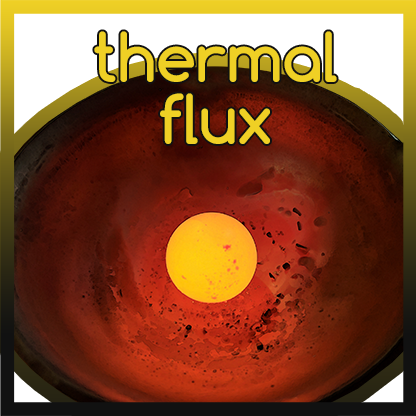Thermal Flux is a sound effects library formed by extreme temperature reactions. With materials ranging from -119°F to 1900°F all captured at 192kHz/24bit, it’s a fiery (and icy) collection of unique sound design source material.
In each recording, props with vast temperature differentials interact with each other… Red hot ball bearings vaporize liquids, melt ice, and destroy various household products. Extremely cold metal instantly freezes water. Molten metals and glass pour into water, groaning, chirping, and crackling, as they solidify. Dry ice causes coins to viciously chatter. Water beads bounce, whine, and buzz on blazing hot pans. White hot sand roars and erupts upon contact with water. All of this and more was recorded with mics capturing quality frequency information up to ~65kHz. This ultrasonic content allows for extreme pitch shifting without compromising fidelity.
Extreme Temperatures
 The recordings in Thermal Flux have a temperature range of over 2000°F! From bone chilling -119°F dry ice to blistering 1900°F molten glass. The heart of Thermal flux is extremely hot and cold objects interacting with each other. All of the sounds you hear are made solely by potential and kinetic thermal energy of the many props… thermodynamics at work!
The recordings in Thermal Flux have a temperature range of over 2000°F! From bone chilling -119°F dry ice to blistering 1900°F molten glass. The heart of Thermal flux is extremely hot and cold objects interacting with each other. All of the sounds you hear are made solely by potential and kinetic thermal energy of the many props… thermodynamics at work!
Ultrasonic Content
 What’s the benefit of 192kHz recordings? Ultrasonic content! When you take a 192kHz file and slow it down enough, these ultrasonic sounds become audible. Not only does this maintain more fidelity when files are slowed down, but it can also reveal aspects of the SFX you’d normally never hear. Thermal flux contains quality frequency information up to ~65kHz, giving you ample room to stretch and morph these sounds in your next project.
What’s the benefit of 192kHz recordings? Ultrasonic content! When you take a 192kHz file and slow it down enough, these ultrasonic sounds become audible. Not only does this maintain more fidelity when files are slowed down, but it can also reveal aspects of the SFX you’d normally never hear. Thermal flux contains quality frequency information up to ~65kHz, giving you ample room to stretch and morph these sounds in your next project.
Multi-Take Files = Less Clutter

Thermal Flux takes advantage of multi-take files for many recordings. Adding 206 FILES to your library might sound nice, but logically organizing those 206 SOUNDS into 64 files makes SFX easier to find in your database and edit in your project. Sounds are organized into multi-take files by the various facets of the recordings. All similar variants of each prop recording are easily accessible within the same file.
Quality Metadata

Thermal Flux comes with thorough metadata that works across all popular audio database software. Each file is embedded with exhaustive information about the recording. Aside from the usual description, many other fields are available that provide useful tidbits like recording notes, microphone information/placement, category, and sub-category. All sound effects also come embedded with an image showing exactly what was happening during the recording.







Reviews
There are no reviews yet.